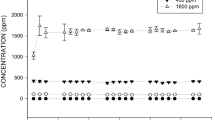Abstract
The experimental study with rats was undertaken to verify the working hypothesis that enzyme induction caused by ethanol consumption affects the kinetics ofm-xylene only at a high level of exposure.m-Xylene was administered to ethanol-treated rats either perorally (0.01, 0.02 or 0.1 ml/kg) or by inhalation (50, 100 or 500 ppm each for 6 h) and the concentration ofm-xylene in the blood and the urinary excretion of am-xylene metabolite (m-methyl hippuric acid orm-MHA) were measured with time. The ethanol consumption, which increased the in vitrom-xylene metabolism about 5-fold, had no effect on the metabolism of inhaledm-xylene in vivo until the exposure concentration was raised to 500 ppm. On the other hand, metabolism ofm-xylene after oral administration was markedly enhanced at any dose by the consumption, as evidenced by a decrease in the blood concentration ofm-xylene together with an increase in the urinary excretion ofm-MHA. These findings indicate that enzyme induction does not affect the pharmacokinetics of inhaledm-xylene when its exposure concentration is low. This may be because the hepatic blood flow, rather than the enzyme activity, rate-limits the metabolism ofm-xylene, which is highly metabolized in the liver.
Similar content being viewed by others
References
David A, Flek J, Frantik E, Gut I, Sedivec V (1979) Influence of phenobarbital on xylene metabolism in man and rats. Int Arch Occup Environ Health 44: 117–125
Hoyumpa AM Jr, Schenker S (1982) Major drug interactions: effect of liver disease, alcohol and malnutrition. Annu Rev Med 33: 113–149
Koop DR, Coon MJ (1986) Ethanol oxidation and toxicity: role of alcohol P-450 oxygenase. Alcohol Clin Exp Res 10: 44–49
Lieber CS, DeCarli LM (1986) 1986 Update: the feeding of ethanol in liquid diets. Alcohol Clin Exp Res 10: 550–553
Lowry OH, Rosebrough NJ, Farr AL, Randall RJ (1951) Protein measurement with the Folin phenol reagent. J Biol Chem 193: 265–275
Nakajima T, Okino T, Okuyama S, Kaneko T, Yonekura I, Sato A (1988) Ethanol-induced enhancement of trichloroethylene metabolism and hepatotoxicity: difference from the effect of phenobarbital. Toxicol Appl Pharmacol 94: 227–237
Nakajima T, Elovaara E, Park SS, Gelboin HV, Hietanen E, Vainio H (1989) Immunochemical characterization of cytochrome P-450 isozymes responsible for benzene oxidation in the rat liver. Carcinogenesis 10: 1713–1717
Nakajima T, Wang RS, Murayama N, Sato A (1990) Three forms of trichloroethylene-metabolizing enzymes in rat liver induced by ethanol, phenobarbital, and 3-methylcholanthrene. Toxicol Appl Pharmacol 102: 546–552
Omura T, Sato R (1964) The carbon monoxide-binding pigment of liver microsomes. 1. Evidence for its hemoprotein nature. J Biol Chem 239: 2370–2378
Ramsey JC, Andersen ME (1984) A physiological model for the inhalation pharmacokinetics of inhaled styrene in rats and humans. Toxicol Appl Pharmacol 73: 159–175
Sato A (1993) Confounding factors in biological monitoring of exposure to organic solvents. Int Arch Occup Environ Health 65 (in press)
Sato A, Nakajima T (1979) A vial-equilibration method to evaluate the drug-metabolizing enzyme activity for volatile hydrocarbons. Toxicol Appl Pharmacol 47: 41–46
Sato A, Nakajima T (1985) Enhanced metabolism of volatile hydrocarbons in rat liver following food deprivation, restricted carbohydrate intake and administration of ethanol, phenobarbital, polychlorinated biphenyl and 3-methylcholanthrene: a comparative study. Xenobiotica 15: 67–75
Sato A, Nakajima T, Fujiwara Y (1975a) Determination of benzene and toluene in blood by means of a syringe-equilibration method using a small amount of blood. Br J Ind Med 32: 210–214
Sato A, Nakajima T, Fujiwara Y, Murayama N (1975b) Kinetic studies on sex difference in susceptibility to chronic benzene intoxication with special reference to body fat content. Br J Ind Med 32: 321–328
Sato A, Nakajima T, Koyama Y (1980) Effects of chronic ethanol consumption on hepatic metabolism of aromatic and chlorinated hydrocarbons in rats. Br J Ind Med 37: 382–386
Sato A, Nakajima T, Koyama Y (1981) Dose-related effects of a single dose of ethanol on the metabolism in rat liver of some aromatic and chlorinated hydrocarbons. Toxicol Appl Pharmacol 60: 8–15
Sato A, Nakajima T, Koyama Y (1983) Interaction between ethanol and carbohydrate on the metabolism in rat liver of aromatic and chlorinated hydrocarbons. Toxicol Appl Pharmacol 68: 242–249
Sato A, Endoh K, Kaneko T, Johanson G (1991) Effects of consumption of ethanol on the biological monitoring of exposure to organic solvent vapours: a simulation study with trichloroethylene. Br J Ind Med 48: 548–556
Steel RGD, Torrie JH (1960) Principles and procedures for statistics. McGraw-Hill, New York, pp 110–111
Takeuchi Y, Sakai T, Ikeya Y, Araki T, Ushio K, Yanagihara S (1986) Improved high performance liquid chromatography determination of hippuric acid and methylhippuric acid isomers in urine. Jpn J Ind Health 28: 455–461
Wrighton SA, Thomas PE, Molowa DT, Haniu M, Shively JE, Maines SL, Watkins PB, Parker G, Mendez-Picon G, Levin W, Guzelian PS (1986) Characterization of ethanol-inducible human liver N-nitrosodimethylamine demethylase. Biochemistry 25: 6731–6735
Author information
Authors and Affiliations
Rights and permissions
About this article
Cite this article
Kaneko, T., Wang, PY. & Sato, A. Enzyme induction by ethanol consumption affects the pharmacokinetics of inhaledm-xylene only at high levels of exposure. Arch Toxicol 67, 473–477 (1993). https://doi.org/10.1007/BF01969918
Received:
Accepted:
Issue Date:
DOI: https://doi.org/10.1007/BF01969918




